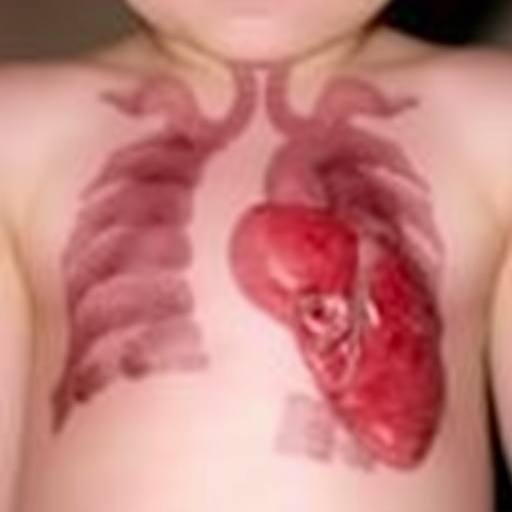In a groundbreaking case that highlights the complexities of genetic disorders, researchers have unveiled a novel variant associated with OTUD6B-related syndrome, the first of its kind recorded in China. This finding not only broadens the understanding of the condition but also shines a light on the intricate interplay between genetic mutations and observable phenotypic manifestations. OTUD6B-related syndrome has been previously documented in literatures, but this latest report introduces compelling new evidence, particularly due to the unique presentation of ocular dysplasia and hypothyroidism in this case.
The study reveals that the child involved, who is now identified as the first Chinese case of OTUD6B-related syndrome, exhibits severe ocular developmental anomalies alongside endocrine dysfunctions. These conditions highlight the necessity of thorough genetic assessment in pediatric patients displaying such unusual symptoms. The collaboration among researchers Chen, Gao, and Hu emphasizes the importance of multi-disciplinary approaches in addressing the complex challenges presented by rare genetic disorders.
Through genetic sequencing methods, the researchers traced the unique variant in the OTUD6B gene to this patient, establishing a direct correlation between the mutation and the observed clinical symptoms. OTUD6B, known for its role in the ubiquitin-proteasome pathway, is crucial for cellular regulation and metabolic processes. The impact of its mutation reflects the dysfunctional cellular processes that can lead to multi-system involvement, which is evident in this particular case.
This discovery is not merely an academic exercise; it carries significant implications for clinical practice and genetic counseling in China and beyond. Geneticists and pediatricians can now use this case to refine diagnostic criteria for OTUD6B-related syndrome, ensuring that similar cases are recognized and managed appropriately. Early recognition of symptoms linked to genetic disorders is vital for implementing timely interventions, which can greatly improve the quality of life for affected individuals.
Furthermore, this case stresses the significance of population-specific studies in genetics. As populations worldwide become increasingly diverse, understanding genetic disorders through the lens of different ethnic backgrounds enriches the collective knowledge within the scientific community. This is particularly relevant in countries with vast genetic variability, such as China.
Healthcare providers are encouraged to maintain high suspicions of rare syndromic presentations in pediatric patients, especially those exhibiting mixed symptoms across multiple systems—ocular, endocrine, or otherwise. Considering these conditions can easily be misdiagnosed or attributed to more common ailments, continued research and documentation are paramount. This case acts as a reminder of the potential insights awaiting discovery in the genome, particularly those that remain elusive in large-scale studies.
The involvement of interdisciplinary teams in the investigation process also underscores a model for future research efforts. Geneticists, ophthalmologists, endocrinologists, and pediatricians can collaborate not only to enhance patient care but also to build extensive databases of cases that can inform future studies. Information sharing and collaboration will be essential as researchers strive to catalog genetic variants and their clinical ramifications.
In addition to the scientific advancements, the emotional journey of the affected families cannot be underestimated. This particular family faced significant uncertainty and stress while navigating the complexities of their child’s condition. Raising awareness about genetic disorders not only helps in scientific research but also provides information and support to families who might be grappling with similar challenges.
As more data emerges about OTUD6B-related syndrome, there is hope for developing targeted therapies that address the root causes of symptoms rather than just managing them. The specificity of gene therapy could revolutionize treatment options for individuals with rare genetic disorders. The precision of such interventions heavily relies on our understanding of the underlying genetic mechanisms.
Creating awareness and fostering dialogue within the medical community about OTUD6B-related syndrome will undoubtedly encourage more research into this and similar conditions. With initiatives aimed at increasing genomic literacy among healthcare professionals, the potential for early diagnosis and intervention grows progressively stronger.
The findings presented here serve as a notable highlight in the ongoing discourse around genetic research, driving home the point that continued efforts in this area are both necessary and impactful. Each new variant uncovered adds another piece to the puzzle of human genetics, providing insight that could have profound implications for medical science.
In conclusion, the case of the first Chinese patient with OTUD6B-related syndrome serves as a reminder of the importance of genetic research in clinical practice and the potential for significant advancements in understanding and treating rare genetic disorders. It underscores a call to action for the medical community to remain vigilant in seeking out the nuances of genetic disorders, thereby ensuring that all patients receive the best possible care, informed by the most current scientific knowledge.
Subject of Research: OTUD6B-related syndrome with ocular dysplasia and hypothyroidism
Article Title: Novel variant causing OTUD6B-related syndrome with ocular dysplasia and hypothyroidism: the first Chinese case
Article References: Chen, J., Gao, D., Hu, J. et al. Novel variant causing OTUD6B-related syndrome with ocular dysplasia and hypothyroidism: the first Chinese case. BMC Pediatr 25, 905 (2025). https://doi.org/10.1186/s12887-025-06272-6
Image Credits: AI Generated
DOI: https://doi.org/10.1186/s12887-025-06272-6
Keywords: OTUD6B-related syndrome, ocular dysplasia, hypothyroidism, genetic mutations, pediatric genetics, case study.
Tags: clinical symptoms of OTUD6B syndromefirst Chinese case of genetic disordergenetic sequencing in pediatric patientshypothyroidism and genetic mutationsinterdisciplinary collaboration in geneticsnovel genetic variants in Chinaocular dysplasia in childrenOTUD6B syndromepediatric genetic assessmentrare genetic disorders researchubiquitin-proteasome pathway importanceunderstanding genetic disorders in children





